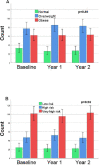Lifestyle factors predict gout outcomes: Results from the NOR-Gout longitudinal 2-year treat-to-target study
- PMID: 38053463
- PMCID: PMC10693886
- DOI: 10.1136/rmdopen-2023-003600
Lifestyle factors predict gout outcomes: Results from the NOR-Gout longitudinal 2-year treat-to-target study
Abstract
Objective: Gout is associated with lifestyle, body mass index (BMI) and comorbidities, including dyslipidaemia. We studied how in actively treated patients, anthropometric measures and lipid levels changed over 2 years and whether they predicted gout outcomes.
Methods: Patients with a recent gout flare and elevated serum urate (sUA) received gout education and treat-to-target urate-lowering therapy over 1 year. Anthropometric measures with BMI, waist circumference (WC) and waist-height ratio (WHR) as well as lipid levels were measured yearly over 2 years. We examined whether baseline anthropometric measures and lipid levels were related to flares and to achieving the sUA target.
Results: At baseline, patients (n=211) were with mean age of 56.4 years and 95% were male. Over 2 years, anthropometric measures were largely unchanged while cholesterol and low-density lipoprotein cholesterol (LDL-C) were reduced at year 1. Anthropometric measures were associated with presence of tophi. Higher baseline WC (OR: 0.96 per cm, 95% CI: 0.93 to 0.99) decreased and high level of high-density lipoprotein cholesterol (OR: 5.1 per mmol/L, 95% CI: 1.2 to 22.1) increased the chance of sUA target achievement at year 2. High LDL-C (OR: 1.8 per mmol/L, 95% CI: 1.2 to 2.6) predicted the chance of having a gout flare during year 2.
Conclusion: In actively treated patients with gout, anthropometric measures were largely unchanged over 2 years and lipid levels were reduced. High WC and lipid levels predicted unfavourable gout outcomes after 2 years.
Keywords: arthritis; gout; lipids; therapeutics.
© Author(s) (or their employer(s)) 2023. Re-use permitted under CC BY. Published by BMJ.
Conflict of interest statement
Competing interests: TU reports personal fees from Grünenthal and Novartis, outside the submitted work. LFK has nothing to disclose. Dr Sexton has nothing to disclose. TKK reports grants and personal fees from AbbVie, MSD, UCB, Hospira/Pfizer, Eli-Lilly, grants from BMS, personal fees from Roche, Hikma, Orion, Sanofi, Celltrion, Sandoz, Biogen, Amgen, Egis, Ewopharma and Mylan, outside the submitted work. EAH reports personal fees from Pfizer, UCB, Eli Lilly, Celgene, Janssen-Cilag, AbbVie and Gilead outside the submitted work. HBH reports personal fees from AbbVie, Lilly and Novartis, outside the submitted work.
Figures
Similar articles
-
12-month results from the real-life observational treat-to-target and tight-control therapy NOR-Gout study: achievements of the urate target levels and predictors of obtaining this target.RMD Open. 2021 Mar;7(1):e001628. doi: 10.1136/rmdopen-2021-001628. RMD Open. 2021. PMID: 33782189 Free PMC article.
-
Two-year reduction of dual-energy CT urate depositions during a treat-to-target strategy in gout in the NOR-Gout longitudinal study.Rheumatology (Oxford). 2022 Apr 18;61(SI):SI81-SI85. doi: 10.1093/rheumatology/keab533. Rheumatology (Oxford). 2022. PMID: 34247224 Free PMC article.
-
One- and 2-year flare rates after treat-to-target and tight-control therapy of gout: results from the NOR-Gout study.Arthritis Res Ther. 2022 Apr 20;24(1):88. doi: 10.1186/s13075-022-02772-3. Arthritis Res Ther. 2022. PMID: 35443675 Free PMC article.
-
Gout Flare Burden, Diagnosis, and Management: Navigating Care in Older Patients with Comorbidity.Drugs Aging. 2021 Jul;38(7):545-557. doi: 10.1007/s40266-021-00866-2. Epub 2021 Jun 9. Drugs Aging. 2021. PMID: 34105100 Review.
-
Overview of Serum Uric Acid Treatment Targets in Gout: Why Less Than 6 mg/dL?Postgrad Med. 2016 Sep;128(7):706-15. doi: 10.1080/00325481.2016.1221732. Epub 2016 Aug 25. Postgrad Med. 2016. PMID: 27558643 Review.
Cited by
-
Efficacy and safety of orlistat in male patients with overweight/obesity and hyperuricemia: results of a randomized, double-blind, placebo-controlled trial.Lipids Health Dis. 2024 Mar 11;23(1):77. doi: 10.1186/s12944-024-02047-7. Lipids Health Dis. 2024. PMID: 38468241 Free PMC article. Clinical Trial.
References
MeSH terms
Substances
LinkOut - more resources
Full Text Sources
Medical


